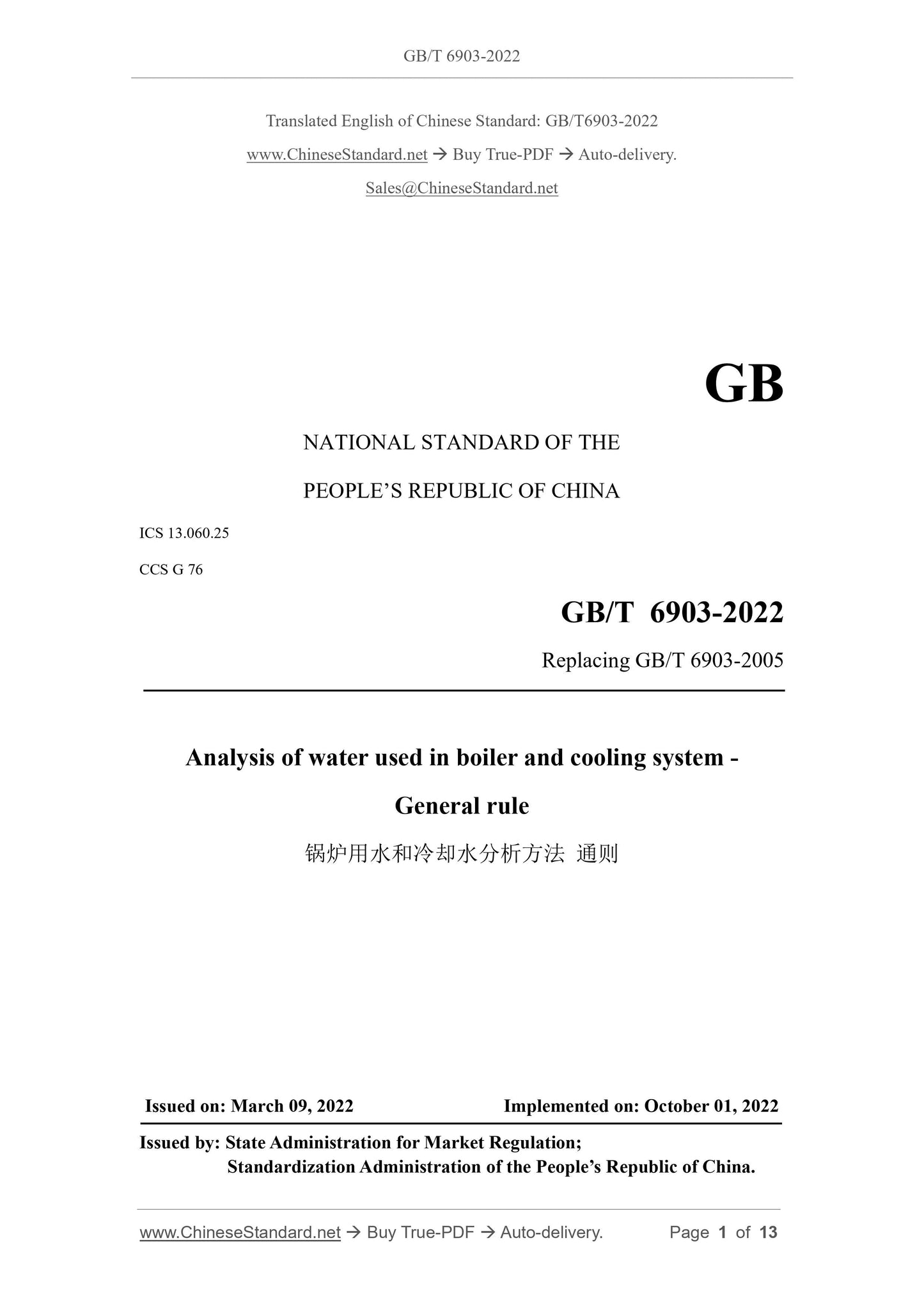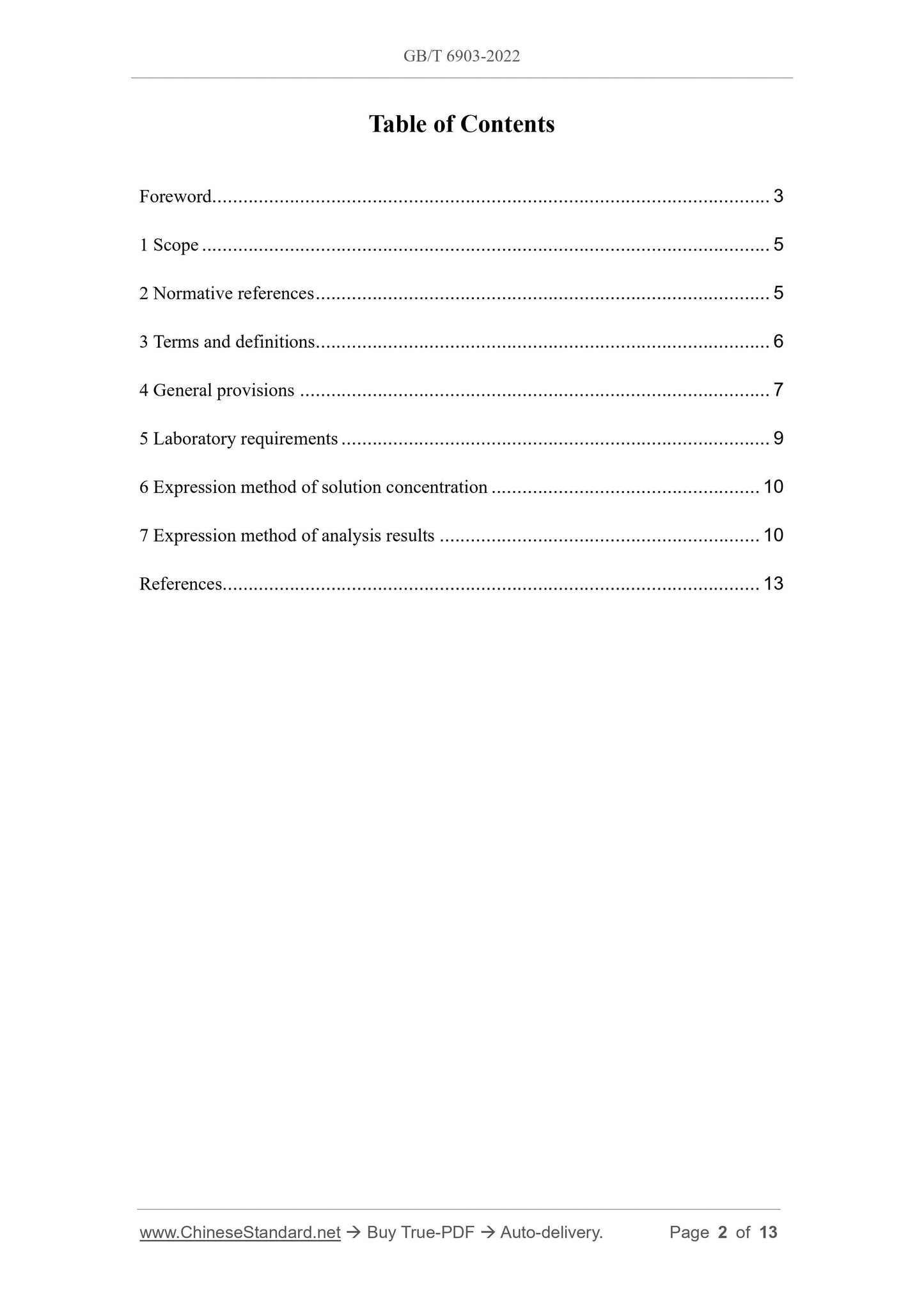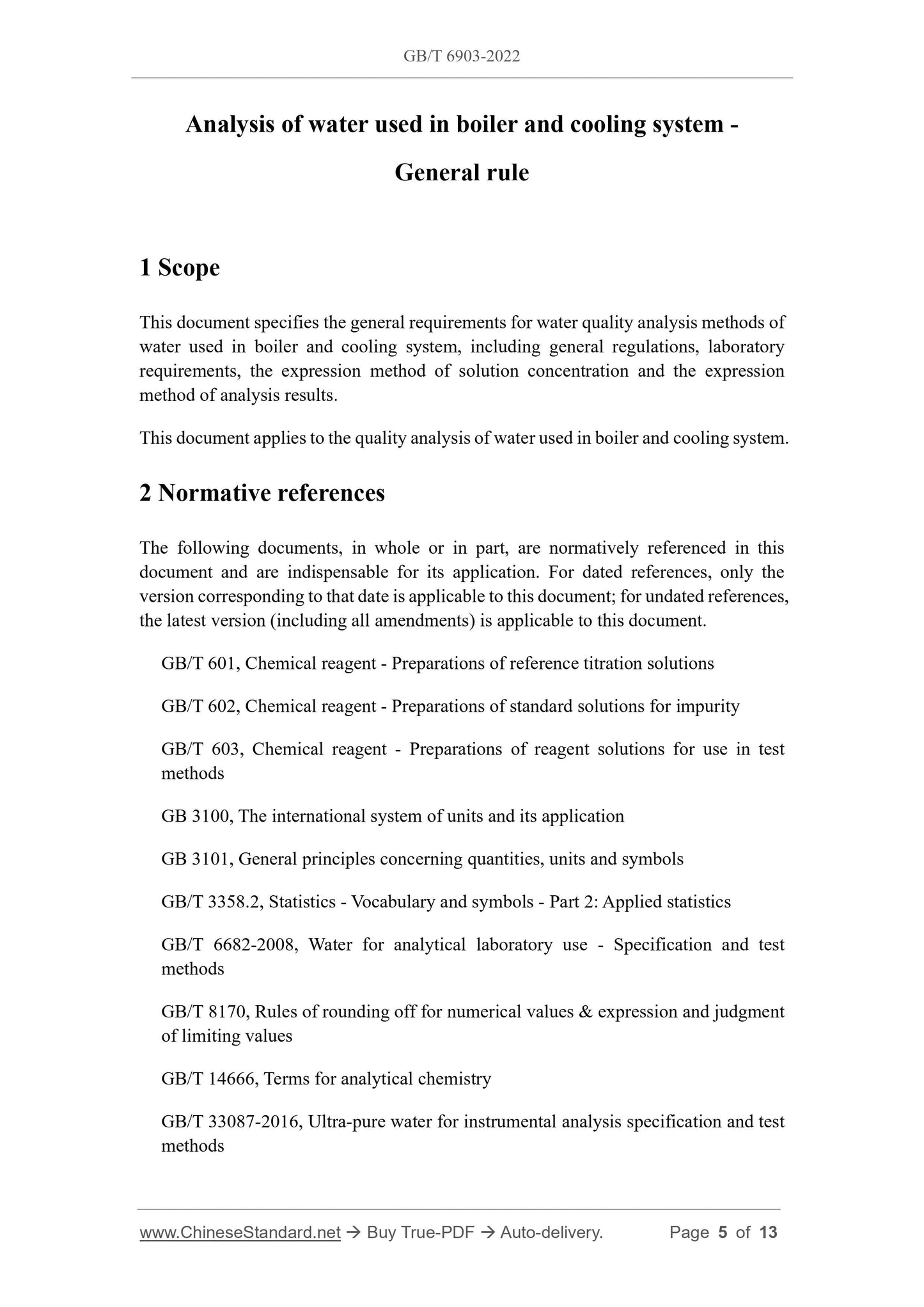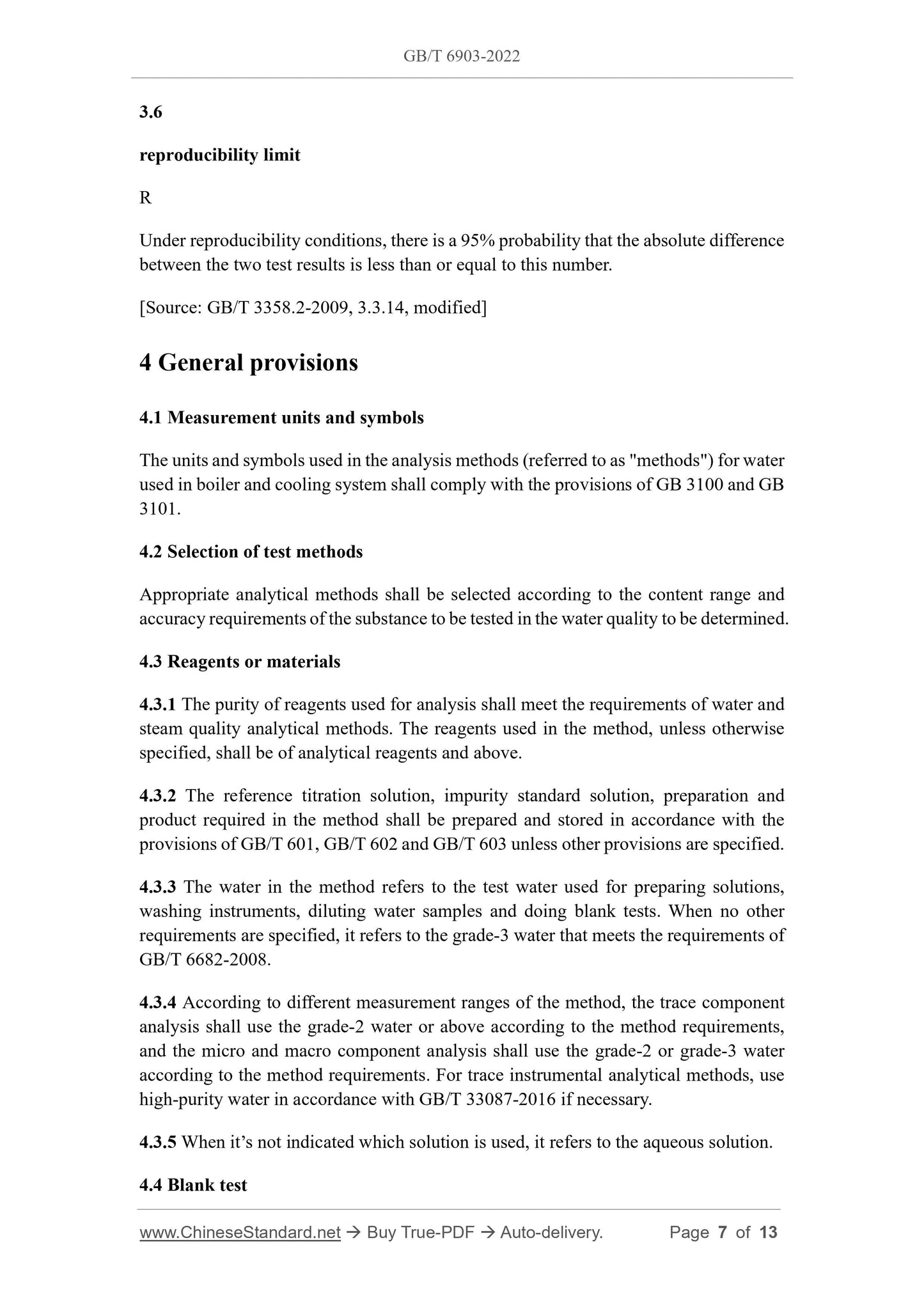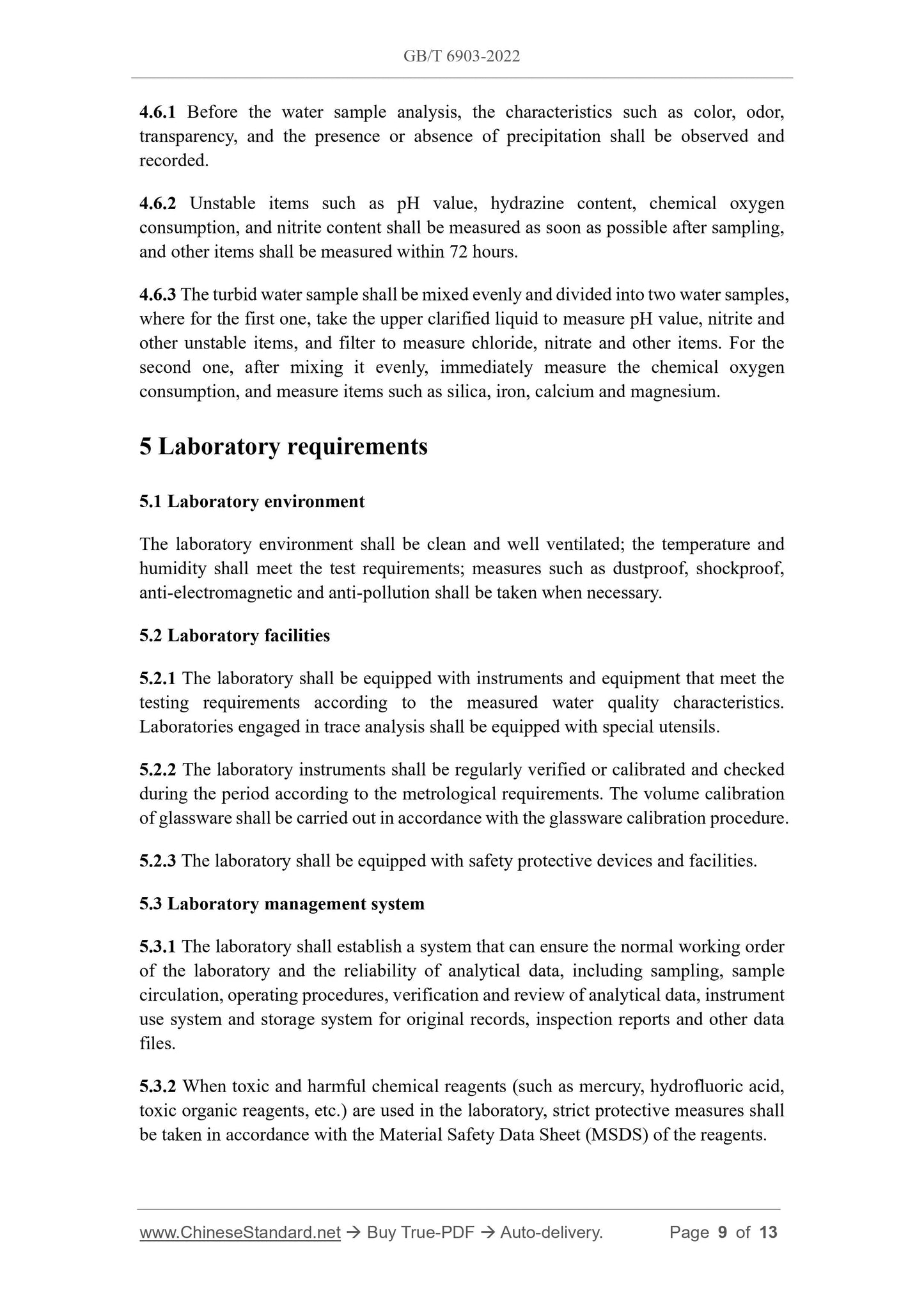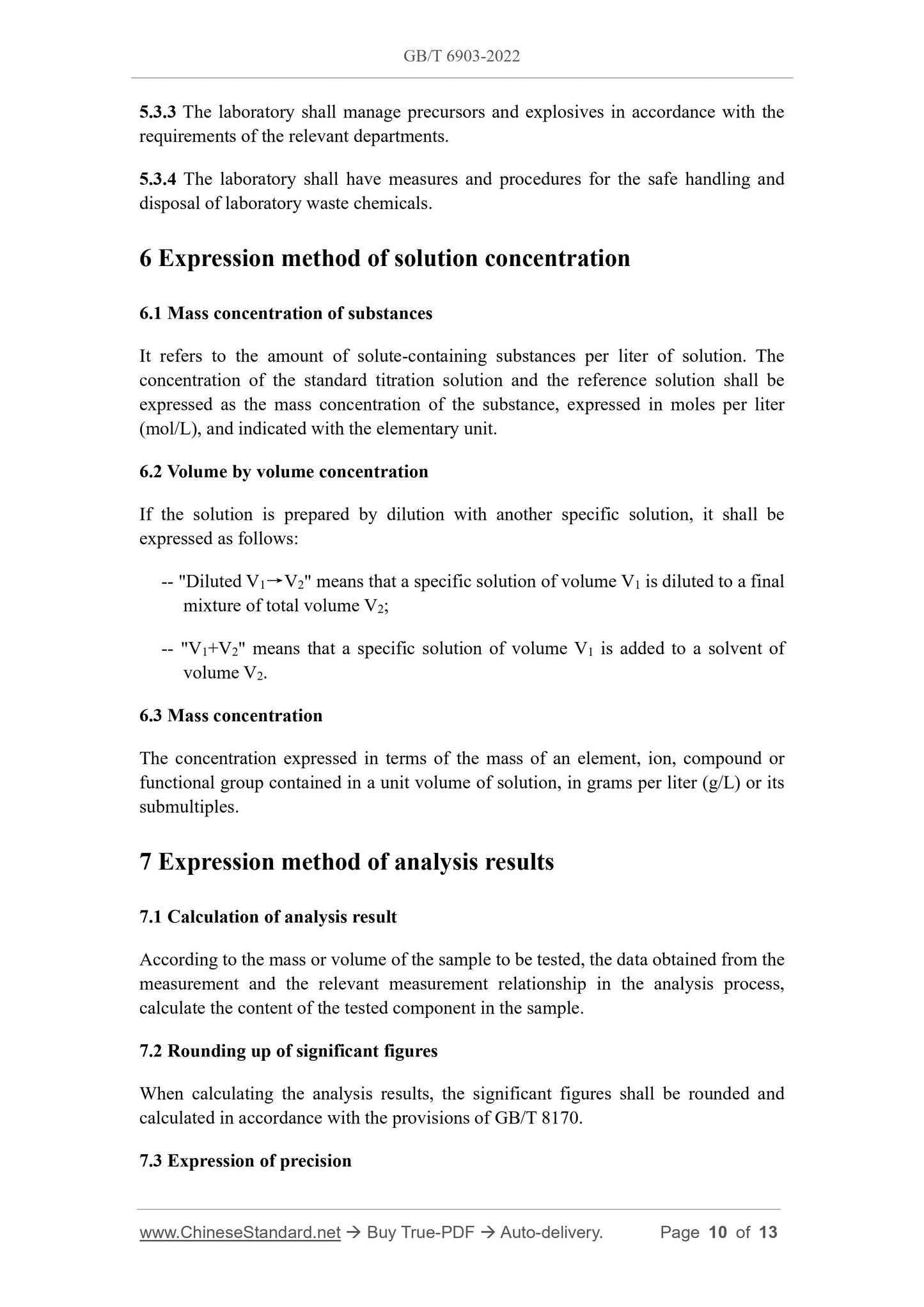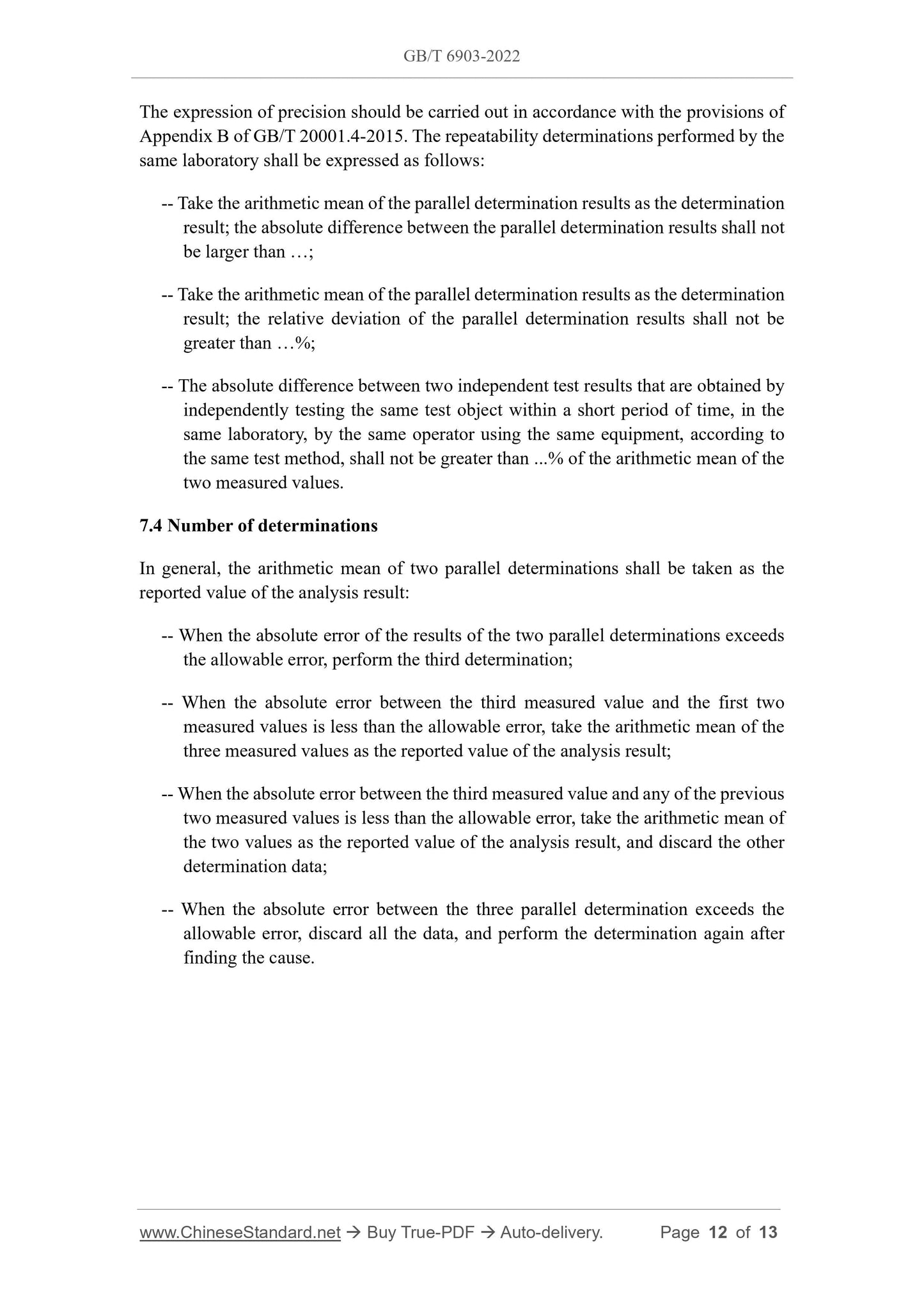1
/
of
7
PayPal, credit cards. Download editable-PDF & invoice in 1 second!
GB/T 6903-2022 English PDF (GBT6903-2022)
GB/T 6903-2022 English PDF (GBT6903-2022)
Regular price
$170.00 USD
Regular price
Sale price
$170.00 USD
Unit price
/
per
Shipping calculated at checkout.
Couldn't load pickup availability
Delivery: 3 seconds. Download true-PDF + Invoice.
Get QUOTATION in 1-minute: Click GB/T 6903-2022
Historical versions: GB/T 6903-2022
Preview True-PDF (Reload/Scroll if blank)
GB/T 6903-2022: Analysis of water used in boiler and cooling system - General rule
GB/T 6903-2022
NATIONAL STANDARD OF THE
PEOPLE’S REPUBLIC OF CHINA
ICS 13.060.25
CCS G 76
Replacing GB/T 6903-2005
Analysis of water used in boiler and cooling system -
General rule
ISSUED ON: MARCH 09, 2022
IMPLEMENTED ON: OCTOBER 01, 2022
Issued by: State Administration for Market Regulation;
Standardization Administration of the People’s Republic of China.
Table of Contents
Foreword ... 3
1 Scope ... 5
2 Normative references ... 5
3 Terms and definitions... 6
4 General provisions ... 7
5 Laboratory requirements ... 9
6 Expression method of solution concentration ... 10
7 Expression method of analysis results ... 10
References ... 13
Analysis of water used in boiler and cooling system -
General rule
1 Scope
This document specifies the general requirements for water quality analysis methods of
water used in boiler and cooling system, including general regulations, laboratory
requirements, the expression method of solution concentration and the expression
method of analysis results.
This document applies to the quality analysis of water used in boiler and cooling system.
2 Normative references
The following documents, in whole or in part, are normatively referenced in this
document and are indispensable for its application. For dated references, only the
version corresponding to that date is applicable to this document; for undated references,
the latest version (including all amendments) is applicable to this document.
GB/T 601, Chemical reagent - Preparations of reference titration solutions
GB/T 602, Chemical reagent - Preparations of standard solutions for impurity
GB/T 603, Chemical reagent - Preparations of reagent solutions for use in test
methods
GB 3100, The international system of units and its application
GB 3101, General principles concerning quantities, units and symbols
GB/T 3358.2, Statistics - Vocabulary and symbols - Part 2: Applied statistics
GB/T 6682-2008, Water for analytical laboratory use - Specification and test
methods
GB/T 8170, Rules of rounding off for numerical values and expression and judgment
of limiting values
GB/T 14666, Terms for analytical chemistry
GB/T 33087-2016, Ultra-pure water for instrumental analysis specification and test
methods
3.6
reproducibility limit
Under reproducibility conditions, there is a 95% probability that the absolute difference
between the two test results is less than or equal to this number.
[Source: GB/T 3358.2-2009, 3.3.14, modified]
4 General provisions
4.1 Measurement units and symbols
The units and symbols used in the analysis methods (referred to as "methods") for water
used in boiler and cooling system shall comply with the provisions of GB 3100 and GB
3101.
4.2 Selection of test methods
Appropriate analytical methods shall be selected according to the content range and
accuracy requirements of the substance to be tested in the water quality to be determined.
4.3 Reagents or materials
4.3.1 The purity of reagents used for analysis shall meet the requirements of water and
steam quality analytical methods. The reagents used in the method, unless otherwise
specified, shall be of analytical reagents and above.
4.3.2 The reference titration solution, impurity standard solution, preparation and
product required in the method shall be prepared and stored in accordance with the
provisions of GB/T 601, GB/T 602 and GB/T 603 unless other provisions are specified.
4.3.3 The water in the method refers to the test water used for preparing solutions,
washing instruments, diluting water samples and doing blank tests. When no other
requirements are specified, it refers to the grade-3 water that meets the requirements of
GB/T 6682-2008.
4.3.4 According to different measurement ranges of the method, the trace component
analysis shall use the grade-2 water or above according to the method requirements,
and the micro and macro component analysis shall use the grade-2 or grade-3 water
according to the method requirements. For trace instrumental analytical methods, use
high-purity water in accordance with GB/T 33087-2016 if necessary.
4.3.5 When it’s not indicated which solution is used, it refers to the aqueous solution.
4.4 Blank test
4.6.1 Before the water sample analysis, the characteristics such as color, odor,
transparency, and the presence or absence of precipitation shall be observed and
recorded.
4.6.2 Unstable items such as pH value, hydrazine content, chemical oxygen
consumption, and nitrite content shall be measured as soon as possible after sampling,
and other items shall be measured within 72 hours.
4.6.3 The turbid water sample shall be mixed evenly and divided into two water samples,
where for the first one, take the upper clarified liquid to measure pH value, nitrite and
other unstable items, and filter to measure chloride, nitrate and other items. For the
second one, after mixing it evenly, immediately measure the chemical oxygen
consumption, and measure items such as silica, iron, calcium and magnesium.
5 Laboratory requirements
5.1 Laboratory environment
The laboratory environment shall be clean and well ventilated; the temperature and
humidity shall meet the test requirements; measures such as dustproof, shockproof,
anti-electromagnetic and anti-pollution shall be taken when necessary.
5.2 Laboratory facilities
5.2.1 The laboratory shall be equipped with instruments and equipment that meet the
testing requirements according to the measured water quality characteristics.
Laboratories engaged in trace analysis shall be equipped with special utensils.
5.2.2 The laboratory instruments shall be regularly verified or calibrated and checked
during the period according to the metrological requirements. The volume calibration
of glassware shall be carried out in accordance with the glassware calibration procedure.
5.2.3 The laboratory shall be equipped with safety protective devices and facilities.
5.3 Laboratory management system
5.3.1 The laboratory shall establish a system that can ensure the normal working order
of the laboratory and the reliability of analytical data, including sampling, sample
circulation, operating procedures, verification and review of analytical data, instrument
use system and storage system for original records, inspection reports and other data
files.
5.3.2 When toxic and harmful chemical reagents (such as mercury, hydrofluoric acid,
toxic organic reagents, etc.) are used in the laboratory, strict protective measures shall
be taken in accordance with the Material Safety Data Sheet (MSDS) of the reagents.
5.3.3 The laboratory shall manage precursors and explosives in accordance with the
requirements of the relevant departments.
5.3.4 The laboratory shall have measures and procedures for the safe handling and
disposal of laboratory waste chemicals.
6 Expression method of solution concentration
6.1 Mass concentration of substances
It refers to the amount of solute-containing substances per liter of solution. The
concentration of the standard titration solution and the reference solution shall be
expressed as the mass concentration of the substance, expressed in moles per liter
(mol/L), and indicated with the elementary unit.
6.2 Volume by volume concentration
If the solution is prepared by dilution with another specific solution, it shall be
expressed as follows:
-- "Diluted V1→V2" means that a specific solution of volume V1 is diluted to a...
Get QUOTATION in 1-minute: Click GB/T 6903-2022
Historical versions: GB/T 6903-2022
Preview True-PDF (Reload/Scroll if blank)
GB/T 6903-2022: Analysis of water used in boiler and cooling system - General rule
GB/T 6903-2022
NATIONAL STANDARD OF THE
PEOPLE’S REPUBLIC OF CHINA
ICS 13.060.25
CCS G 76
Replacing GB/T 6903-2005
Analysis of water used in boiler and cooling system -
General rule
ISSUED ON: MARCH 09, 2022
IMPLEMENTED ON: OCTOBER 01, 2022
Issued by: State Administration for Market Regulation;
Standardization Administration of the People’s Republic of China.
Table of Contents
Foreword ... 3
1 Scope ... 5
2 Normative references ... 5
3 Terms and definitions... 6
4 General provisions ... 7
5 Laboratory requirements ... 9
6 Expression method of solution concentration ... 10
7 Expression method of analysis results ... 10
References ... 13
Analysis of water used in boiler and cooling system -
General rule
1 Scope
This document specifies the general requirements for water quality analysis methods of
water used in boiler and cooling system, including general regulations, laboratory
requirements, the expression method of solution concentration and the expression
method of analysis results.
This document applies to the quality analysis of water used in boiler and cooling system.
2 Normative references
The following documents, in whole or in part, are normatively referenced in this
document and are indispensable for its application. For dated references, only the
version corresponding to that date is applicable to this document; for undated references,
the latest version (including all amendments) is applicable to this document.
GB/T 601, Chemical reagent - Preparations of reference titration solutions
GB/T 602, Chemical reagent - Preparations of standard solutions for impurity
GB/T 603, Chemical reagent - Preparations of reagent solutions for use in test
methods
GB 3100, The international system of units and its application
GB 3101, General principles concerning quantities, units and symbols
GB/T 3358.2, Statistics - Vocabulary and symbols - Part 2: Applied statistics
GB/T 6682-2008, Water for analytical laboratory use - Specification and test
methods
GB/T 8170, Rules of rounding off for numerical values and expression and judgment
of limiting values
GB/T 14666, Terms for analytical chemistry
GB/T 33087-2016, Ultra-pure water for instrumental analysis specification and test
methods
3.6
reproducibility limit
Under reproducibility conditions, there is a 95% probability that the absolute difference
between the two test results is less than or equal to this number.
[Source: GB/T 3358.2-2009, 3.3.14, modified]
4 General provisions
4.1 Measurement units and symbols
The units and symbols used in the analysis methods (referred to as "methods") for water
used in boiler and cooling system shall comply with the provisions of GB 3100 and GB
3101.
4.2 Selection of test methods
Appropriate analytical methods shall be selected according to the content range and
accuracy requirements of the substance to be tested in the water quality to be determined.
4.3 Reagents or materials
4.3.1 The purity of reagents used for analysis shall meet the requirements of water and
steam quality analytical methods. The reagents used in the method, unless otherwise
specified, shall be of analytical reagents and above.
4.3.2 The reference titration solution, impurity standard solution, preparation and
product required in the method shall be prepared and stored in accordance with the
provisions of GB/T 601, GB/T 602 and GB/T 603 unless other provisions are specified.
4.3.3 The water in the method refers to the test water used for preparing solutions,
washing instruments, diluting water samples and doing blank tests. When no other
requirements are specified, it refers to the grade-3 water that meets the requirements of
GB/T 6682-2008.
4.3.4 According to different measurement ranges of the method, the trace component
analysis shall use the grade-2 water or above according to the method requirements,
and the micro and macro component analysis shall use the grade-2 or grade-3 water
according to the method requirements. For trace instrumental analytical methods, use
high-purity water in accordance with GB/T 33087-2016 if necessary.
4.3.5 When it’s not indicated which solution is used, it refers to the aqueous solution.
4.4 Blank test
4.6.1 Before the water sample analysis, the characteristics such as color, odor,
transparency, and the presence or absence of precipitation shall be observed and
recorded.
4.6.2 Unstable items such as pH value, hydrazine content, chemical oxygen
consumption, and nitrite content shall be measured as soon as possible after sampling,
and other items shall be measured within 72 hours.
4.6.3 The turbid water sample shall be mixed evenly and divided into two water samples,
where for the first one, take the upper clarified liquid to measure pH value, nitrite and
other unstable items, and filter to measure chloride, nitrate and other items. For the
second one, after mixing it evenly, immediately measure the chemical oxygen
consumption, and measure items such as silica, iron, calcium and magnesium.
5 Laboratory requirements
5.1 Laboratory environment
The laboratory environment shall be clean and well ventilated; the temperature and
humidity shall meet the test requirements; measures such as dustproof, shockproof,
anti-electromagnetic and anti-pollution shall be taken when necessary.
5.2 Laboratory facilities
5.2.1 The laboratory shall be equipped with instruments and equipment that meet the
testing requirements according to the measured water quality characteristics.
Laboratories engaged in trace analysis shall be equipped with special utensils.
5.2.2 The laboratory instruments shall be regularly verified or calibrated and checked
during the period according to the metrological requirements. The volume calibration
of glassware shall be carried out in accordance with the glassware calibration procedure.
5.2.3 The laboratory shall be equipped with safety protective devices and facilities.
5.3 Laboratory management system
5.3.1 The laboratory shall establish a system that can ensure the normal working order
of the laboratory and the reliability of analytical data, including sampling, sample
circulation, operating procedures, verification and review of analytical data, instrument
use system and storage system for original records, inspection reports and other data
files.
5.3.2 When toxic and harmful chemical reagents (such as mercury, hydrofluoric acid,
toxic organic reagents, etc.) are used in the laboratory, strict protective measures shall
be taken in accordance with the Material Safety Data Sheet (MSDS) of the reagents.
5.3.3 The laboratory shall manage precursors and explosives in accordance with the
requirements of the relevant departments.
5.3.4 The laboratory shall have measures and procedures for the safe handling and
disposal of laboratory waste chemicals.
6 Expression method of solution concentration
6.1 Mass concentration of substances
It refers to the amount of solute-containing substances per liter of solution. The
concentration of the standard titration solution and the reference solution shall be
expressed as the mass concentration of the substance, expressed in moles per liter
(mol/L), and indicated with the elementary unit.
6.2 Volume by volume concentration
If the solution is prepared by dilution with another specific solution, it shall be
expressed as follows:
-- "Diluted V1→V2" means that a specific solution of volume V1 is diluted to a...
Share
